Dr. David Gorski has quite a bit to say about “quackademic medicine.”
“Quackademic,” a portmanteau of quack and academic, means exactly that. “It’s the infiltration of quackery into academic medicine,” Gorski said. “I wish I had coined [the term], but I didn’t.”
Gorski is a surgical oncologist, a professor at the Wayne State University School of Medicine, and the managing editor of the blog Science-Based Medicine. Gorski himself has been accused of quackery and has developed a degree of internet infamy among anti-vaccination advocates for his staunch and public criticism of their movements. He has been the subject of several smear campaigns which have, without evidence, accused him of everything from being a paid shill for the pharmaceutical industry to having associations with pedophiles. What Dr. Gorski sees as “quackademics” is not the anti-vaccination movement, however, but something else, something that can be found much closer to the Hilltop: the Georgetown University Medical Center M.S. of Physiology in Complementary and Alternative Medicine (CAM) program.
The CAM program was founded in 2001 by Hakima Amri, who holds a doctorate in biochemistry and reproductive physiology, and Aviad Haramati, who holds a doctorate in physiology. The program was based on a National Institutes of Health grant to develop a curriculum to expose graduate students to the field of complementary and alternative medicine in a critical and evidence based way.
What exactly is “complementary and alternative medicine”? Technically, there are three similar but distinct terms for the field: alternative, complementary, and integrative. “Alternative medicine is essentially anything outside the mainstream of medicine. The term complementary medicine came into being in the U.K., because what they found was that people weren’t using [these practices] instead of conventional medicine, which is what the term alternative connotes, but rather to complement treatments in conventional medicine,” Haramati said. “Integrative medicine is really the blending of both conventional and nonconventional, bringing the best evidence from both to improve patient wellbeing and the health of the public.”
Haramati prefers the term integrative medicine to describe the curriculum of the CAM program, which covers subjects like naturopathy, homeopathy, chiropractic medicine, acupuncture, reiki, yoga, mindfulness, and other systems of non-conventional medicine.
As one of the leading names in integrative medicine education, Georgetown has been in Gorski’s crosshairs. On July 27, 2015, Gorski published an entry on Science-Based Medicine titled “Bastions of Quackademic Medicine: Georgetown University.” Specifically, the post addressed the Spring/Summer issue of Georgetown Medicine, which was dedicated to the CAM program and associated research. “Georgetown is telling its medical students: Forget all that boring old reductionist ‘Western’ science you’ve learned all these years,” Gorski wrote. “Open your mind to the sympathetic magic that is homeopathy. Never mind that it has no basis in science and its precepts violate multiple well-established laws of physics and chemistry.”
The CAM faculty doesn’t see it that way, however. “As scientists and academicians, as long as we have the evidence, and our statements are evidence-based, then that’s what we’re going to teach our students,” Amri said. “I want [our critics] to show me what they have read that is really a good study,
and shows negative effects. If there are negative effects, I want to know also. I want to show that to the students. We are not teaching the students to become advocates of the field. That’s not our focus. Our focus is to teach them how to separate the good from the bad.”
Haramati, a self-described skeptic, sees this as in line with Georgetown’s Jesuit philosophy. When he started the program, he met with university President DeGioia, andwarned him that there could be pushback. “I told him, ‘We are going to explore areas with objectivity, and with rigor, and isn’t that the Jesuit way?’”
Gorski also believes that students should be taught about complementary and alternative practices, but he sees far less gray area. “I’ve always said that physicians should know about alternative medicine, but that isn’t the problem. The problem is that it’s taught in a credulous fashion, as though it were accepted, as though it deserves to be ‘integrated’ into regular science-based medicine,” Gorski said. “These programs are not taught by skeptics or critical thinkers who are familiar with the evidence and know why the evidence doesn’t show that these things work. They’re taught by believers.”
Still, Gorski doesn’t believe that everything taught under the umbrella of integrative medicine is pure fiction. “There are parts of integrative medicine that potentially work, but they’re the parts any primary care physician will already recommend, things like diet modifications, exercise, et cetera,” he said. “The good parts of integrative medicine are not unique to integrative medicine, but what is unique is not good.”
The truly alternative fields have already been discredited for Gorski. For example, he describes acupuncture, which has gained popularity and acceptance in recent years, as “a theatrical placebo,” where the location of the needles, or whether or not they penetrate the skin, doesn’t make a difference in the result. “The problem with giving a placebo with no effect is that you’re basically forced to lie,” Gorski said.
Haramati doesn’t see it that way. “The body has the intrinsic ability to heal itself. If our mind perceives that a treatment is helping us, and we can leverage that through engagement and treatment, isn’t that what we’re after?” he said. “If this is a less invasive and less deleterious form of treatment that can help the patient, I can’t imagine why we would not want to do that.”
Placebo or not, it is hard to dismiss all those interested in integrative medicine as quacks. The Department of Defense, in response to the opioid epidemic, has been investigating acupuncture, mindfulness, and other integrative treatments to help veterans with chronic pain. “This is the military,” Haramati said. “They’re not exactly San Francisco hippies.” The CAM program itself uses the same scientific standards as any other program in the Medical Center. “We’re not going to be teaching students about crystals. We are careful about what subjects we bring to the table. There is something called ‘biological plausibility,’ where we start with practices that are common and which there is an evidence base for.”
Haramati does understand the tendency for conventional medicine to reject some alternative practices. In 2010, he led a delegation to India to gather data on Ayurveda, a system of Indian traditional medicine. He was disappointed with the state of research in the country. “If you want to make a dent in the Western scientific world, you’re going to have to use the scientific method.”
If history is any indication though, each side could find affirmation for some of its ideas as evidence builds. Gorski cites laetrile, also erroneously known as vitamin B-17, a substance extracted from stone fruit pits. “In the 70s, it was touted as a magical mystery cancer cure,” Gorski said. “We eventually did clinical trials on it in the early ’80s and showed it doesn’t work.” Actor Steve McQueen died of pleural mesothelioma in Mexico, having traveled there to seek treatment with laetrile.
For Haramati, mindfulness demonstrates just the opposite. “The Buddhists have promoted the practice of mindfulness for a very long time. In the ’70s, John Kabat-Zinn at the University of Massachusetts brings this practice, secularizes it, and teaches it to patients with chronic pain as a way to become present in the moment,” Haramati said. Today, mindfulness has become a mainstream practice for dealing with physical pain, as well as a host of mental illnesses.
The next decade of data will shed more light on the very debates that swirl around the Hilltop today. But until then, don’t expect people like Gorski, Amri, and Haramati to stop speaking their minds.







[…] An Integrative Education: Georgetown’s Complementary and Alternative Medicine Program Sparks D… The Georgetown Voice […]
[…] Voice about quackademic medicine for an article that was published a week ago entitled “An Integrative Education: Georgetown’s Complementary And Alternative Medicine Program Sparks Debat….” Not surprisingly, the article was basically “balanced,” with quotes from me as […]
[…] An Integrative Education: Georgetown’s Complementary and Alternative Medicine Program Sparks D… The Georgetown Voice […]